Doing it in the dust
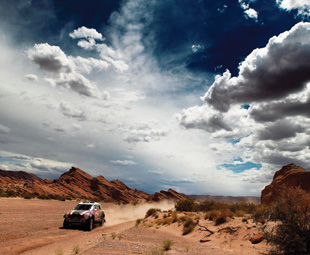
“Welcome to hell. I’m the mayor.” That’s what the organisers should say to Dakar competitors, as CHARLEEN CLARKE discovers in Argentina…
Champagne and air-conditioning. That’s how the 2012 Dakar kicked off for me. It’s the day before the actual event starts and we’re in the holiday town of Mar del Plata – a bit like Durban, but with more Italian restaurants and gazillions of huts on the beach. We’ve gathered to celebrate the anticipated success of the South African Dakar team and the mood is very festive. This is the first time a Toyota Hilux will compete in the Dakar! South African flags fly outside the window; one of the South Africans even has a massive blow-up hand in the colours of our flag.
Then it’s time for the ceremonial start: a massive podium has been erected at Plaza Colón… just a stone’s throw away from the beaches. Alas, thousands upon thousands of rally fans have gathered to watch the 443 vehicles start the race… making it impossible to get near the podium.
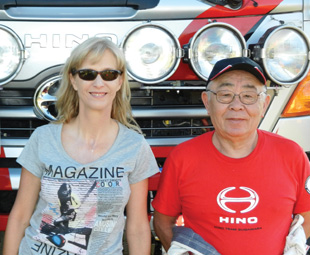 I’m heart broken. I’m desperate to see 2009 Dakar winners South African Giniel de Villiers and German co-driver Dirk von Zitzewitz in their “local is lekker” Toyota Hilux bakkie on the podium. So I decide to gatecrash the VIP area, which is located adjacent to the podium. I adopt my most confident VIP mode and march onwards and upwards into this holy of all holy areas. Only to get evicted. Unceremoniously. I don’t have the required VIP armband. No chance of getting in.
I’m heart broken. I’m desperate to see 2009 Dakar winners South African Giniel de Villiers and German co-driver Dirk von Zitzewitz in their “local is lekker” Toyota Hilux bakkie on the podium. So I decide to gatecrash the VIP area, which is located adjacent to the podium. I adopt my most confident VIP mode and march onwards and upwards into this holy of all holy areas. Only to get evicted. Unceremoniously. I don’t have the required VIP armband. No chance of getting in.
So it’s time for Plan B. The back door next to the kitchen. Surprisingly, it opens. There’s a couch blocking my way, but I sneak into the area anyway, clambering over some rather alarmed VIPs.
I’m in! And I’m just a couple of metres away from the podium! The area is decidedly posh, with all sorts of gourmet nibbles up for grabs and a full bar, well stocked with the most exotic drinks.
But I’m not interested in those: I want to catch the action!
What a fabulous experience it turns out to be (it should be; it costs a ridiculous €1 000 to gain entrance to this area). I feel as though I can almost reach out and touch the 2011 winner – the almost insanely fast Nasser Al-Attiyah, who has teamed up with a former rival, Robby Gordon. Al-Attiyah is at the wheel of a Hummer H3 decorated in the colours of his native country, Qatar.
Because he won the race in 2011 he’s first off the line – followed by our local lad, Giniel. I beam with pride at the sight of a fellow South African on the podium…
Another highlight is Robby Gordon. In typical Gordon fashion (the man is completely nuts), he ramps the podium. The crowd roars its delight.
A dozen cars later it’s the turn of the second South African Hilux – commandeered by Duncan Vos and Rob Howie. Gosh, it’s just so cool to see our boytjies here.
Then it’s a mad dash back to the hotel to change for the New Year’s Eve party. I bump into the entire South African team (I’m talking about the technicians and back-up crew) in the pub. They’re watching the start on television. Why, I ask? There are lots of pickpockets at the start, I’m told. They have a captive audience: the crowd is enthralled by the automotive spectacle unfolding so pickings are very easy…
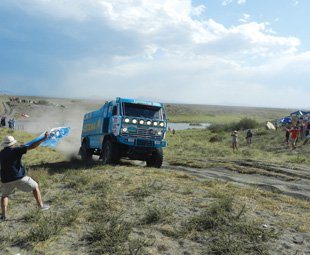 Our New Year’s Eve celebrations a thing of the past (what a fireworks display; it lasts for well over two hours, with each and every local letting rip with a rocket or two), it’s time for day one of the Dakar. Ahead lie more than 8 000 km of high-speed stages through desert scrubland, dry river beds and canyons, insanely high temperatures in the Atacama Desert and a high altitude (4 700 metres above sea level) crossing of the Andes Mountains in sub-zero temperatures.
Our New Year’s Eve celebrations a thing of the past (what a fireworks display; it lasts for well over two hours, with each and every local letting rip with a rocket or two), it’s time for day one of the Dakar. Ahead lie more than 8 000 km of high-speed stages through desert scrubland, dry river beds and canyons, insanely high temperatures in the Atacama Desert and a high altitude (4 700 metres above sea level) crossing of the Andes Mountains in sub-zero temperatures.
I cannot contain my excitement! The same can be said of South African bikers Iain Stevenson, Neil Scott-Thomas, Darryl Curtis and Greg Raaf. Their motorcycles had been delayed on the ship transporting them to the race. Right up to the very last minute they didn’t know if they could race or not – simply because their bikes had not arrived. But now, at the 11th hour, their bikes are in Mar del Plata, they’ve been scrutineered (the organisers bent over backwards) and the boys are keen to rock and roll.
So too are we, and we head out on the road, following the directions of our Trippy (a computerised road book come navigation system programmed by the race organisers, which tells us where to go). The dastardly Trippy also monitors our speed; because we are an official vehicle, part of the South African team, we are constantly under surveillance by Big Brother Trippy. If we speed, the South African team will be penalised (I don’t want to be the one to break this news to De Villiers).
Leaving Mar del Plata is nothing short of a wonderful and utterly delightful experience. Because, for the first 400 km, local race fans line the road and wave enthusiastically. Our Hilux is decalled (just like the race vehicles). Therefore, the fans don’t discriminate between us and De Villiers, for instance (and they all know who he is; he is seriously famous in South America). We wave back for 400 km; eventually my arm gets so sore I have to rest it on the cooler box and give a slightly more sedate wave.
We stop en route to refuel (fuelling stations are a nightmare in Argentina; out in the countryside, we often battle to find one), and I am asked to pose for photographs and sign autographs. It’s all such a giggle.
Some 550 km later, we finally arrive at the racing stage (see my Dakar for Dummies sidebar for an explanation of this). And just in time too. The South African team is elated – De Villiers emerges from the stage first. There is no sign of Al-Attiyah! There are lots of chortles of glee from the South African contingent, which is sheltering in the shade. (The temperature is well over 40 °C; it is as hot as Hades… how the drivers and co-drivers cope, I cannot imagine.) There is even more glee some 20 minutes later, when Al-Attiyah emerges from the stage – but at the end of Gordon’s tow rope (2 km away from the end of the special stage, his H3 ground to a halt due to problems with oil pressure).
More bad news follows. Another South African – Alfie Cox – is out of the race. His Volvo XC60 has burnt to a cinder. (Cox thinks it was a power steering fluid leak.) At least he has escaped unharmed.
The same cannot be said of biker Jorge Martinez Boero. He crashes on the first stage and dies.
At the bivouac (read Dakar for Dummies) that evening, we chat about this extremely sad turn of events. I encounter an incredibly cynical technician. “He is dead. So? That is Dakar. That is why people come here. They come because it is tough. This will only attract more competitors. One dies; two more come…”
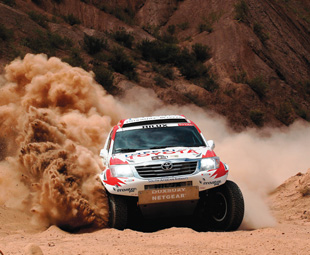 I understand what he is saying: the Dakar is renowned for being dangerous. This reputation was firmly reinforced back in 1982, when Mark Thatcher, son of the then British Prime Minister Margaret Thatcher, along with his French co-driver Charlotte Verney and their mechanic, disappeared for six days. On January 9, the trio became separated from a convoy of vehicles after they stopped to make repairs to a faulty steering arm. They were declared missing on January 12; after a large-scale search, a Lockheed L100 search plane from the Algerian military spotted their white Peugeot 504 some 50 km off course. Thatcher, Verney and the mechanic were all unharmed.
I understand what he is saying: the Dakar is renowned for being dangerous. This reputation was firmly reinforced back in 1982, when Mark Thatcher, son of the then British Prime Minister Margaret Thatcher, along with his French co-driver Charlotte Verney and their mechanic, disappeared for six days. On January 9, the trio became separated from a convoy of vehicles after they stopped to make repairs to a faulty steering arm. They were declared missing on January 12; after a large-scale search, a Lockheed L100 search plane from the Algerian military spotted their white Peugeot 504 some 50 km off course. Thatcher, Verney and the mechanic were all unharmed.
But, while I understand the technician’s point of view, after a 900 km drive, I hasten to escape his cynical attitude for the air-conditioning of my hotel. As I relax on my bed, I wonder about the technicians, who will work on the vehicles until two or three in the morning… and then sleep in a tent on the ground…
Day two involves more heat and hundreds and hundreds of kilometres again – en route from Santa Rosa de la Pampa to San Rafael, some 500 km due north. But, before we hit the road, I grab some time with the most extraordinary man. His name is Yoshimasa Sugawara and, at the princely age of 70, he is doing his 30th Dakar.
Sugawara is driving a Hino 500 Series, but he has competed in all categories (bike, quad, car and truck). In fact, he’s a legend within the Dakar fraternity – not surprisingly, given the fact that he holds records for the highest number of Dakar entries (30 and counting) and the most consecutive finishes (21 to date).
Sugawara’s racing career kicked off when he was 24 years old. His interest in the Dakar was piqued when he read about the race in a motorcycle magazine. “My first Dakar was in 1983 on a bike,” he recalls. “It didn’t end well. I broke my leg and had to retire. It was really, really tough; I had no support team and I was completely alone. It was very hard.”
Sugawara says the race has changed dramatically over the years. “It was more of an adventure when I first started because there was no technology; I only had a magnetic compass. The vehicles are also much faster today – they are specifically engineered for high speed,” he explains.
After a spell with quads and cars, Sugawara made the shift to trucks in 1992. “I have driven a Hino every single year since then, barring 2008 – when the race was cancelled. The Hino is a very good, reliable truck that never breaks down. It never abandons us,” he notes. Sugawara says that his racing experiences impact on each and every Hino operator. “We are proud to assist with the development of new parts for trucks,” he points out.
Sugawara leaps into his cab and we hit the road, in search of the Hiluxes – which are not missing a beat. The same can be said of Al-Attiyah who, after his day one incident, began in 38th position. In the first 290 km, he overtakes 17 cars! The favourite to win the race is still Stéphane Peterhansel, in a Mini. But Al-Attiyah is certainly giving it a tonk of note.
In the bivouac that night, I am chatting to one of the Toyota technicians – who is dead on his feet and utterly desperate for a beer. (Beer is streng verboten; each and every team member has to be totally focused.) “I slept for two hours last night,” he recalls. “During last night’s stay in Santa Rosa de la Pampa, there were huge spiders that seemed hell bent on getting into our tents, causing an early-hours-of the-morning ruckus and fair bit of excitement on the way. That’s Dakar for you – we sleep when we can,” he says with a wry smile. Sometimes this means nodding off for 10 minutes in the middle of the day. But I wonder how they manage this – the heat is extreme, the distances are vast and there are absolutely no creature comforts. This is not a race for sissies!
This much is confirmed the following day, when I see the medical helicopter land at the end of the special stage. A biker by the name of Quinn Cody has broken his collarbone following a spectacular fall after 173 km of the special stage. Of course, some would say he’s lucky. He has escaped Dakar with his life.
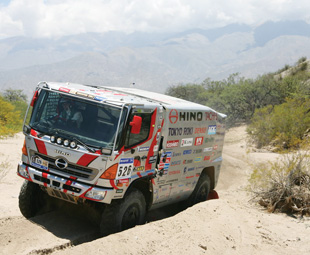 That night, it’s back to the bivouac, for analysis of the day’s racing and lots and lots of hard work for the technicians. “It is interesting to note that the top three cars – a Diesel Mini, a Hummer shelled special vehicle and a Toyota Hilux – are separated by 1 minute and 40 seconds,” one of the technicians points out. The competition isn’t just intense; it’s clear that the drivers and their vehicles are fairly evenly matched.
That night, it’s back to the bivouac, for analysis of the day’s racing and lots and lots of hard work for the technicians. “It is interesting to note that the top three cars – a Diesel Mini, a Hummer shelled special vehicle and a Toyota Hilux – are separated by 1 minute and 40 seconds,” one of the technicians points out. The competition isn’t just intense; it’s clear that the drivers and their vehicles are fairly evenly matched.
I giggle at one of the spectators; his shoes have – quite literally – fallen apart at the seams. I ask him what happened. “It was the heat today. It was so extreme that the glue holding the shoe together simply melted.”
Day four sees the competitors racing through the canyons between the Andes in long sweeping, sandy riverbeds. It is surreal landscape where layers of the earth’s crust jut up into the sky from the flat desolation of the barren countryside.
But I don’t get to marvel at this wonder of nature. All too soon, my Dakar days are a thing of the past. I am leaving Argentina. Heading for South Africa. Bearable weather. Gourmet food. And a good night’s sleep. But, for the competitors, the nightmare has just begun…
Dakar for dummies
Everyone knows the Dakar. But there is a lot of confusion surrounding the event – its name, for instance. For this reason, CHARLEEN CLARKE has produced her very own Dakar for Dummies guide.
What is the Dakar?
The Dakar Rally (or simply “The Dakar”; formerly known as “The Paris–Dakar” or “Paris to Dakar Rally”) is an annual rally raid type of off-road race, organised by the Amaury Sport Organisation (ASO). It organises sporting events including the Tour de France, Paris Marathon and French Open.
When did the Dakar start?
The Dakar adventure began back in 1977, when Thierry Sabine got lost on his motorbike in the Libyan Desert during the Abidjan-Nice Rally. He returned to France, determined to share this landscape with as many people as possible. He proceeded to come up with a route starting in Europe, continuing to Algiers and crossing Agadez before eventually finishing at Dakar. A total of 182 vehicles turned up in the Place du Trocadéro for a 10 000-kilometre journey into the unknown. Only 74 of these trailblazers made it to the Senegalese capital.
It’s called the Dakar – but doesn’t go there now?
Correct. The race took place in Africa until 2007. After the murder of four French citizens and three Mauritanian soldiers in the days before the start, and answering the strong recommendation of the French Ministry for Foreign affairs not to go to Mauritania, the 2008 edition of the rally was cancelled. The organisers subsequently decided to move the event to South America, because it is deemed safer than Africa. The race has now been run in 27 countries, including Peru which made its debut this year.
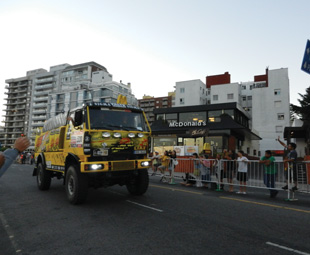 How long is the race?
How long is the race?
This year’s route equated to about 8 300 km, roughly double the distance covered during an entire South African championship season.
But the racing stages are shorter?
Correct. There are special (racing) stages, which are timed, and liaison stages – which take the competitors from the bivouac to the start of the racing stage, and then from the end of the racing stage to the next bivouac.
What is a bivouac?
This is a tented town, established each and every night by the organisers. It includes showers for the competitors and a massive dining area, where the participants enjoy remarkably good food.
Are all the vehicles the same?
No – although there are plans in place to “level the playing fields” from 2013 (the engines will be restricted). The Hilux, with its V8 Toyota engine, already meets these regulations. The BMW twin turbo-engined Minis that finished first and second do not.
What sort of vehicles take part?
There are four titles up for grabs at the Dakar: motorcycle, quad, car and truck.
Has a woman ever won Dakar?
Yes. In 2001, Jutta Kleinschmidt became the first woman to win the Dakar, driving a Mitsubishi Pajero/Montero, with fellow German Andreas Schulz as her co-driver.
Sources: ASO, Wikipedia
Dakar in numbers
10: The record number of victories at the rally held by Stéphane Peterhansel – with six wins on motorcycles and three in cars (he did it again this year)
20, 3, 5: The age in years, months and days of the youngest competitor in the rally, Argentinean Lucas Bonetto (quads)
50: The number of nationalities present at the rally
71, 3, 19: The age in years, months and days of the oldest competitor in the rally, Francisco Claudio Regunaschi (cars). Hino driver, Yoshimasa Sugawara, is 70
133: The number of French competitors in the race, representing the biggest national group with 18% of the total number of competitors
190: The number of countries where footage of the Dakar was broadcast
210: The number of organisation vehicles used at the rally on a daily basis (including 40 cars, 11 helicopters, 12 aeroplanes, 55 trucks, five buses)
260: The number of journalists following the entire rally (this year 1 800 accredited members were involved in the event)
450: In cubic centimetres, the maximum permitted cylinder capacity for the engines of motorcycles taking part in the rally. This is the first time that this limit was imposed on all the competitors
742: The number of competitors taking part in the race (pilots, co-pilots and mechanics)
980: The number of competitors participating as members of assistance teams
1 200: The estimated total hours of Dakar footage broadcast by TV channels from all over the world (based on 2011 data)
1978: The 1st edition, dated 1979, kicked off on December 26 of that year
8 373: The number of kilometres covered between Mar del Plata and Lima, with 4 406 kilometres’ worth of special stages for motorcycles and 4 191 for cars
15 500: The number of carbon equivalent tonnes offset by the Dakar as part of the Madre de Dios project against deforestation, for a total sum of US$ 200 000
5 million: The number of spectators who came to see the Dakar start, finish or pass by in 2011, in Argentina and Chile.
73,5 million: The number of page views on the www.dakar.com website during the 2011 edition of the rally
280 million: In dollars, the direct and indirect economic windfall generated by the Dakar for Argentina, as estimated by a study conducted by this country’s government in 2011
1 billion: The number of TV viewers who watched pictures of the Dakar in 2011
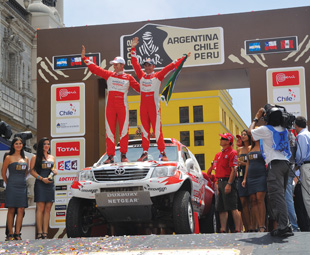
Success for Hilux and Hino!
Team Imperial Toyota concluded its maiden foray into the ultimate test of endurance with a third place for Giniel de Villiers and Dirk von Zitzewitz in the number 301 Hilux, and an 11th place for Duncan Vos and Rob Howie in the number 313 sister car – while the team Overdrive entered South African Hilux of Lucio Alvarez and Andy Graue finished sixth.
Hino continued to build on its amazing record of successes in the gruelling 2012 Dakar Rally, this time notching up its third consecutive victory in the category for trucks with engines of less than 10-litres capacity. The highest placed Hino 500 Series truck, crewed by Teruhito Sugawara and Seiichi Suzuki, placed an excellent ninth overall in a field dominated by so-called “monster trucks” with much larger engines and many of them specially developed for this event.
The second Hino, driven by Teruhito’s 70-year-old father, Yoshimasa and co-driver Hiroyuki Sugiura, placed 24th overall and third in the 10-litre engine category. Second in this class was the Mercedes-Benz Axor of Dutchmen Johan Elfrink and co-driver Hortulanus, which finished 14th overall, almost five hours behind the leading Hino.
Published by
Focus on Transport
focusmagsa



 !
Starting 1 April, every
!
Starting 1 April, every


 FUSO: Driving the Future of Mobile Healthc
FUSO: Driving the Future of Mobile Healthc



 A brand
A brand




 Wondering about the maximum legal load for a
Wondering about the maximum legal load for a 
 The MAN hTGX powered by a hydrogen combus
The MAN hTGX powered by a hydrogen combus


 Exciting News for South African Operators
Exciting News for South African Operators



